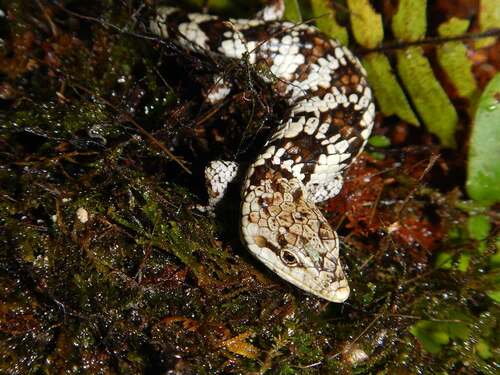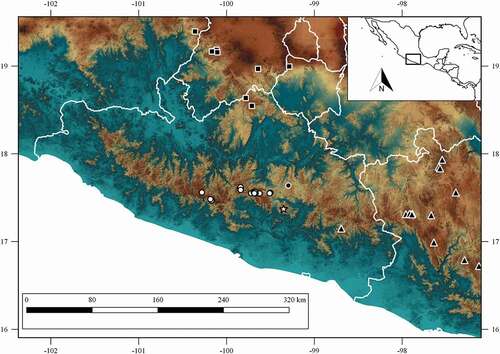ABSTRACT
Alligator lizards of the genus Abronia are a clade of arboreal and terrestrial squamates distributed throughout much of the highlands of Mexico and Central America. Here, we report a new record of the Mexican endemic A. martindelcampoi that represents the easternmost limit of the species and the lowest known elevational record. We briefly discuss the biogeographical hypotheses that have been proposed in the past concerning this and other related genera.
The southern highlands of Mexico harbor a large number of endemic amphibian and reptile species, many of which are restricted to a single mountain range or a handful of localities surrounding their type localities [Citation1,Citation2]. These restricted distributions largely contribute to the status of many of these species as being threatened or vulnerable [Citation3], although in many cases, this classification is due to the lack of information and sampling, especially in mountainous regions. Many central questions on the biogeography and evolutionary biology of species can be more properly formulated and explored only if their distributions are adequately documented [Citation4]. Similarly, distributional data are fundamental for implementing and proposing effective conservation measures [Citation5]. Additionally, imperfectly known distributions and sampling biases hamper an understanding of existing biodiversity and may lead to incorrect biogeographic and/or taxonomic inferences [Citation6].
Alligator lizards of the genus Abronia are an interesting group of squamates that are particularly species-rich in the Mexican highlands [Citation7]. Martín del Campo’s Arboreal Alligator Lizard (Abronia martindelcampoi) is an anguid species endemic to the central portion of the Sierra Madre del Sur in Guerrero, Mexico, known from an elevational interval between 2100 and 2600 meters above sea level (m asl) [Citation8,Citation9]. It is considered an endangered species by the International Union for the Conservation of Nature [Citation10] and the Environmental Vulnerability System [Citation11] mainly due to the limited extent of its known geographic distribution, as well as habitat loss from forest fires and uncontrolled logging activities.
Here, we report a distributional range extension of Martín del Campo’s Arboreal Alligator Lizard (Abronia martindelcampoi) and comment on the biogeography of its congeners in Guerrero, Mexico. On 26 July 2018, an unsexed juvenile Abronia martindelcampoi (MZFC 34838; ) was collected at Plan Barrido, 1680 m asl, 1 km S Coaxtlahuacán, municipality of Mochitlán Guerrero by TEC-M. The lizard was found in the grass in a valley surrounded by remnants of oak forest. When captured, the lizard was observed rolling on grass near a dirt road and constantly opening its mouth. We assume that this behaviour was caused by insolation, while the lizard was trying to reach cover in another remnant of forest. Voucher specimens were deposited in the herpetological collection at the Museo de Zoología “Alfonso L. Herrera”, Facultad de Ciencias, UNAM (MZFC). Specimen identification was verified by Jonatan A. Campbell.
Figure 1. Juvenile specimen of Abronia martindelcampoi (MZFC 34838) from Sierra de Mochitlán, Guerrero, Mexico

This locality extends the known range by 40.8 km SE from the nearest known locality to the west (2 km SE from Omiltemi [Citation7]) and 31 km S from a record from “Amula” (=Almolonga) located west of the Chilpancingo Depression (BMNH 1913.7.19.102 [Citation12]; ), but see below for further comments on this locality. Another record from the “Vicinity of Chilpancingo” (AMNH 72543) is too imprecise for georeference, but most likely refers to the higher elevations, west of the city. The new locality reported herein also represents the lowest elevation record for the species, ~420 m below the 2100 m reported by Flores-Villela and Sánchez-H [Citation8].
Figure 2. Geographic distribution of arboreal species of Abronia in the highlands of southern Mexico. Closed squares: A. deppi, closed triagles: A. mixteca, closed circle: A. aff martindelcampoi, open circles: A. martindelcampoi, star: new record. Records were obtained by the consultation of online (VertNet) and museum (MZFC) databases, as well as personal collection data and pertinent literature

Most species of the genus Abronia are known from a handful of specimens, often solely from their type specimens and the immediate vicinity of their type localities [Citation7]. Several biogeographic peculiarities have been addressed within this group of arboreal lizards, one of the most noteworthy being the apparent allopatry between most species. However, this biogeographic pattern has proven in some cases to be a result of imperfect sampling, as syntopy [Citation13] and sympatry [Citation7,Citation14,Citation15] have been reported in some species of the genus. Also, it has recently been shown that Abronia and its supposed sister taxon Mesaspis are non-monophyletic [Citation16]. This result has important impacts on our understanding of their biogeographic patterns and the taxonomic treatment of these Mesoamerican lizards. First, sympatry would then be proven to be widespread within this clade, as both terrestrial and arboreal species may be found at a given locality, suggesting that arboreality has multiple origins through the evolutionary history of these lizards and their ranges (compare given ranges in [Citation6,Citation14,Citation17]). Additionally, major physical lowland barriers, such as the Isthmus of Tehuantepec and the Balsas Depression, have effectively isolated these highland taxa in the past, directly affecting how arboreal and terrestrial species are phylogenetically related [Citation16,Citation17].
Within Guerrero, six taxa in this genus are found according to the phylogenomic study of Gutiérrez-Rodríguez et al. [Citation16] and previous authors [Citation7,Citation8] (): A. deppii, known from the south-central portion of the Trans-Mexican Volcanic Belt, including the Sierra de Taxco in Guerrero; A. martindelcampoi, endemic to the western and central portions of the Sierra Madre del Sur in Guerrero, frequently found in sympatry with the terrestrial Abronia gadovii gadovii; A. mixteca, known from a single specimen in the Sierra de Malinaltepec, near the border with Oaxaca; Abronia g. levigata, distributed at the easternmost portion of the Sierra Madre del Sur of Guerrero; and an undescribed species allocated to A. deppii by Smith [Citation12] and tentatively to A. martindelcampoi by Flores-Villela and Sánchez-H [Citation8], and Gutiérrez-Rodríguez et al. [Citation16]. The new record presented herein represents the easternmost record of A. martindelcampoi sensu stricto and highlights the importance of geographic barriers in shaping herpetofaunal diversity. Whereas the Chilpancingo depression and the Río Azul drainage isolate populations of A. martindelcampoi and A. aff. martindelcampoi and likely the formation of these intermontane valleys and the subsequent breaks in habitat continuity promoted the divergence between these two taxa, the lowlands and habitat discontinuity between the Sierra de Chilpancingo and the Sierra de Mochitlán apparently have not had the same effect. These same topographic features have been suggested as the main barriers isolating other groups of taxa, such as salamanders [Citation18] and restricting gene flow between anuran populations [Citation19]. The use of time-calibrated phylogenies and integrative studies, including co-distributed taxa in the Sierra Madre del Sur, may shed some light on the questions of how much time is needed to isolate different populations and how the heterogeneous habitat and terrain have shaped species distributions over evolutionary time in this interesting region.
Acknowledgments
We thank Rufino Santos Bibiano, Emmanuel A. Cantú and Gael Palacios Carbajal for their invaluable assistance during the fieldwork. Fieldwork was conducted under a collecting permit issued by Dirección General de Vida Silvestre, Secretaria de Medio Ambiente y Recursos Naturales (#FAUT-0015). Oscar Flores-Villela provided access to museum records and databases that helped to properly address the geographic distribution of the species addressed in this contribution. Victor Hugo Colín-Martínez and Leticia Ochoa-Ochoa helped with cataloguing of specimens at the MZFC. Jonathan A. Campbell, Israel Solano-Zavaleta and Brett O. Butler provided helpful suggestions and interesting comments that greatly improved the quality of this contribution.
Disclosure statement
This work deals with species subject to illegal traffic, exact coordinates might be obtained upon direct request to the authors.
Additional information
Funding
References
- Johnson JD, Wilson LD, Mata-Silva V, et al. The endemic herpetofauna of Mexico: organisms of global significance in severe peril. Mesoam Herpetol. 2017;4(3):544–620.
- Flores Villela O, Ochoa-Ochoa LM. Estado de conocimiento y conservación de la herpetofauna de la Sierra Madre del Sur. En: Luna-Vega I, Espinosa D, Contreras-Medina R, editors. Biodiversidad de la Sierra Madre del Sur. Ciudad de México: Universidad Nacional Autónoma de México; 2016. p. 367–380, 528.
- García-Padilla E, DeSantis DL, Rocha A, et al. Conserving the Mesoamerican herpetofauna: the most critical case of the priority level one endemic species. Amph Rep Cons. 2020;14:73–132.
- Whittaker RJ, Riddle BR, Hawkins BA, et al. The geographical distribution of life and the problem of regionalization: 100 after Alfred Russel Wallace. J Biogeogr. 2013;40:2209–2214.
- Clause AG, Luna-Reyes R, Jiménez Lang N, et al. Problems with imperfect locality data: distribution and conservation status of an enigmatic pitviper. Amph Rep Cons. 2020;14:185–192.
- Köhler G, Gómez Trejo Pérez R, Petersen CBP, et al. A revision of the Mexican Anolis (Reptilia, Squamata, Dactyloidae) from the Pacific versant west of the Isthmus of Tehuantepec in the states of Oaxaca, Guerrero, and Puebla, with the description of six new species. Zootaxa. 2014;3862:1–210.
- Campbell JA, Frost DR. Anguid lizards of the genus Abronia: revisionary notes, description of four new species, a phylogenetic analysis, and key. Bull Am Mus Nat Hist. 1993;216:1–121.
- Flores-Villela O, Sánchez-H. O. A new species of Abronia (Squamata: Anguidae) from the Sierra Madre Del Sur of Guerrero, Mexico, with comments on Abronia deppii. Herpetologica. 2003;59:524–531.
- Palacios-Aguilar R, Flores-Villela O. An updated checklist of the herpetofauna from Guerrero, Mexico. Zootaxa. 2018;4422:1–24.
- Canseco-Márquez L, Campbell JA, Ponce-Campos P, et al. Abronia martindelcampoi. The IUCN Red List of Threatened Species; 2007: e.T63681A12696144. [cited 2020 Nov 02]. Available from: https://doi.org/https://dx.doi.org/10.2305/IUCN.UK.2007.RLTS.T63681A12696144.en
- Wilson LD, Mata-Silva V, Johnson JD. A conservation reassessment of the reptiles of Mexico based on EVS measure. Amph Rep Cons. 2013;7:1–47.
- Smith HM. Notes on the enigmatic Barisia imbricata of the British Museum, and on its collection of reptiles from Amula, Guerrero, Mexico. Bull Maryland Herpetol Soc. 1984;20(4):152–158.
- Aldape-López CT, Santos-Moreno A. Ampliación de la distribución geográfica de Abronia oaxacae (Squamata: Anguidae) y Tantalophis discolor (Squamata: Colubridae) en el estado de Oaxaca, México. Acta Zool Mex. 2016;32:116–119.
- Clause AG, Solano-Zavaleta I, Soto-Huerta KA, et al. Morphological similarity in a zone of sympatry between two Abronia (Squamata: Anguidae), with comments on ecology and conservation. Herpetol Cons Biol. 2018;13:183–193.
- Peterson T, Nieto-montes de Oca A. Sympatry in Abronia (Squamata: Anguidae) and the problem of Mario del Toro Aviles’ specimens. J Herpetol. 1996;30:260–262.
- Gutierrez-Rodríguez J, Zaldívar-Riverón A, Solano-Zavaleta I, et al. Phylogenomics of the Mesoamerican alligator-lizard genera Abronia and Mesaspis (Anguidae: Gerrhonotinae) reveals multiple independent clades of arboreal and terrestrial species. Mol Phylogenet Evol. 2020;154:106963.
- Good DA. Phylogenetic relationships among Gerrhonotine lizards: an analysis of external morphology. Contrib Mus Vert Zool Univ Calif Berkeley. 1988;121:i–x±1–139.
- Palacios-Aguilar R, Cisneros-Bernal AY, Arias-Montiel JD, et al. A new species of Bolitoglossa (Amphibia: Plethodontidae) from the central highlands of Guerrero, Mexico. Canad J Zool. 2020;98:359–365.
- Streicher JW, Devitt TJ, Goldberg CS, et al. Diversification and asymmetrical gene flow across time and space: lineage sorting and hybridization in polytypic barking frogs. Mol Ecol. 2014;23:3273–3291.
